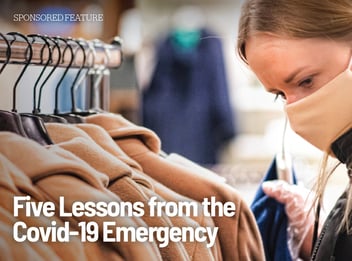Why some things don’t sell online
It feels like online shopping has been around forever. Most retailers – even if they won’t mail your purchases to your door – will at least be entertaining the possibility of Click and Collect. From alcohol, CDs, DVDs, chocolate and flowers, which dominated the early days of e-commerce back in the 90s, to today’s wide range of offerings including electronics, home wares and apparel, almost anything can be summoned to your door with a click.
However, as prolific as online shopping has become, some things just don’t sell online. This immediately creates a spectrum, explaining why some products are harder to sell digitally than others. For retailers with big online ambitions the sooner they identify the hard to sell items, the better. One of the models that can shed light on the sale-ability of items can be illustrated as follows, using quadrant analysis.

Let’s explore the four quadrants.
High Cost, Low Uncertainty
Things that fall here include electronics and other big ticket items that can be classified as commodities. Mass-production stuff like smartphones, media systems, speakers, appliances, game consoles, branded homewares and alcohol.
Customers will gladly buy such items online, usually only going to a brick-and-mortar store to have a look and to use the free customer service to learn as much as possible about the product. Having learned everything needed, they then shop online for the lowest price.
Customers love this segment as it provides easy and precise price comparison. However, from the retailer’s perspective, this is a race to the bottom in which it is difficult to distinguish yourself from the crowd. Whoever sells with the most credibility at the lowest price, wins.
Retailers operating here include Apple, Dan Murphy’s, and Kogan.
Low Cost, High Uncertainty
Things that fall here include custom printed T-shirts, footwear, clothing and other things that won’t break the bank if they don’t end up matching your expectations. They’re things that you can buy blind and not regret. This works particularly well if the retailer has a brick and mortar store nearby, allowing consumers to take the stock back if they don’t like it.
Retailers operating here include eBay, Etsy, and the online sales channels of some apparel retailers.
Note that some savvy people have moved items that belong in this quadrant to the low cost/low uncertainty section. They visit the local store of an expensive brand, try the garment and then go online and buy it overseas for substantially less. Quite a few global retailers in Australia charge more down under than e.g. in the UK or in the US, to the point that even with shipping costs, the items cost less when purchased overseas.
Low Cost, Low Uncertainty
In this quadrant you will find books, movies, music, stationery, vitamins, and dietary supplements. Anything consistent enough that it requires no more thought beyond the first successful purchase.
Retailers operating here include Officeworks, RedBubble and Steam. Additionally, this quadrant is Amazon’s main base of operations.
The issue with this quadrant is that it’s the most alluring space to operate in. The stock sold here is either easily mass-produced, or can even be cloned trivially as software. Demand here will be not only high, but also reliable. Expected prices vary widely, especially in online retail, and all the more for obscure or exclusive products. What’s not to like?
Well, that’s what everyone else thought, too – a decade or two ago. Now, this place is saturated to the brim. Everyone operating in this space either got there early, or has something significant differentiating their offering from that of others.
If you can make it here, more power to you, but there’ll be some elbowing through crowds in your future.
High Cost, High Uncertainty
Jewelry, tailored and/or one-of-a-kind garments, high-quality-but-not-iconic artworks, small production run items, and – as pictured – symbolic jewelry e.g. engagement rings.
Nobody here operates with a degree of success worth the trouble. Not in the online space. And therein lies the rub.
If your business is sitting here, every purchase your consumers make is a significant gamble. They don’t know what they’re buying – not exactly. If they dislike it, they don’t know if they can get it fixed, or send it back. If they send it back, they don’t know how long it will take.
However, just because people are unlikely to buy high-risk products online doesn’t mean you cannot use an online presence to lure them into your store. These days, 60-70% of consumers do research online prior to buying a product, be it online or in-store.
In the Digital Path to Purchase comprising Inspiration, Research, Selection and Purchase, Inspiration, Research and Selection can still occur online – and oftentimes better than can be done in-store.
Hence, if high-risk products are the only thing you’re selling, the main purpose of your online presence may not be to close sales, but rather to extend the presence of your brand into cyberspace.
So if you’re in the wrong spot, what can you do about it?
If you’re in the low cost/low uncertainty quadrant, branch out of your quadrant up and to the right. Increase your product range to include items that are more expensive and more difficult to draw comparisons between. One option is to include home-branded goods in your product range. Even if they don’t sell well, they will shift the reference point in customers’ minds.
If you’re in the high cost/high uncertainty quadrant, you could branch out to the left and down, but try to figure out how to mitigate the risk before you take this path. This would be of immense value, as the top-right quadrant can also be the most profitable – if you can make it work.
In your efforts to decrease uncertainty, work on strengthening your brand. Open concept stores, where customers can interact with your offered product directly, as well as return unwanted stock. Nurture and use customer feedback, as good testimonies are worth their weight in gold.
Offer extra guaranties and no-frills returns. Above all, recognise the importance of the Digital Path to Purchase and persevere online, even if actual online orders are rarer than you’d like. If your website becomes busy, your stores will experience a corresponding increase in traffic.
Online statistics, by quadrant
Other than outlining how a product range fits into the four quadrants, and how to manage each quadrant in the online space, this article highlights the shallow nature of most internet sales statistics. Numbers such as ‘14% of sales in the UK being done online’ are meaningless – and any retailer trying to benchmark their performance against such aggregate values would be unwise. Online sales analysis must be done by category, which accounts for the respective idiosyncrasies of each of the four quadrants.
Finally, there is another dimension to the four quadrants. In some verticals, such as fresh produce and groceries, you might be perfectly happy not to sell online – and it would be a wise decision. Aldi doesn’t sell online in Australia, and for a good reason. Frozen and refrigerated stock cannot be delivered if there is no one at home. Produce cannot be selected for shoppers the way they would select it. Shipping dry groceries makes little sense for a retailer, with high shipment mass and a low margin.
Thus, while we need to be aware that some things will sell online better than others, some don’t belong there at all.






